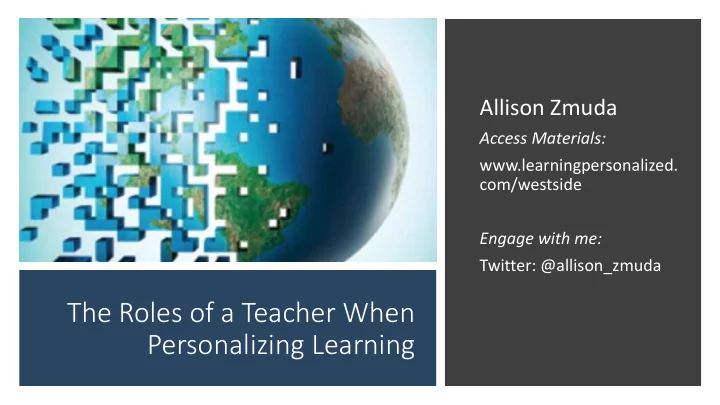

Allison Zmuda Access Materials: www.learningpersonalized. com/westside Engage with me: Twitter: @allison_zmuda The Roles of a Teacher When Personalizing Learning
VUCA Volatile Uncertain Complex Ambiguous U.S. Army War College 2
Definition of Personalized Learning Personalized learning is a progressively student-driven model where students deeply engage in meaningful, authentic, and rigorous challenges to demonstrate desired outcomes. — Zmuda, Curtis, Ullman (2015) 5
6
Four Attributes to Build Culture for Thinking 7
What’s visible in a personalized learning environment? • The image of learner: the learner is seen as capable, willing, & intelligent. • Educators know each learner (strengths, areas for growth, passions, interests). • Educators engage the learner from their strengths and knows how to extend the learning and recalibrate when necessary. • The learning experience is meaningful for each learner because they have a voice and agency in the learning process, deciding evidence to demonstrate the learning and co-construction of success criteria and pace at which they learn. • The learning is connected to the learner’s passions, interests and experiences. • The learning is a reflective process with goal setting, resources and tools to work towards success. • The learning is framed around clearly articulated learning goals, skills, knowledge, competencies, assessment outcomes and success criteria. 8
Antiquated Learning Model Only some learners have access to full taxonomy
Reimagined Learning Model • All students need to have foundational thinking and fluency skills. • All students need to be challenged by non-routine application of skills, content, and potentially innovative experiences.
What impact does this have on our roles? 12
Three Interrelated Roles Focus on developing responsive learning Lead plans by balancing Learner classical and contemporary Facilitator practices and eliminating antiquated ones Coach 13
What pedagogy best serves engagement? From Bold Moves (Jacobs and Alcock, 2017) Antiquated Classical Contemporary pedagogy: What pedagogy: What pedagogy: What do we cut? do we keep? do we create? 14
Identifies and provides models for • what to learn, how to learn, and how to demonstrate learning Teacher as Uses direct instruction and Lead • Learner modeling as primary teaching mode Provides immediate intervention to • point out errors and redirect the learning 15
Tools for Lead Learner Limited Technology With Technology • Lectures are chunked to about 10 • Video lectures so that students can min with consolidation replay as needed immediately after • Collaborative notetaking amongst • Explicit modeling on note-talking students to ensure salient points are captured • Formative assessments (entrance and exit tickets) • Immediate response tools (e.g., Flip Grid, Socrative, Google Form) • Multiple ways to communicate to focus next steps, clarify of directions/next steps directions, or address misconceptions 16
Pause and Reflect: Teacher as Lead Learner A Lead Learner… v What are some of the strategies you use as a Identifies and provides models • for what to learn, how to lead learner? learn, and how to demonstrate learning v How do you make certain Uses direct instruction and • modeling as primary teaching that you are leading mode students to their own Encourages participation and • thinking as they engage values contributions with the material? 17
● Designs tasks that invite inquiry, analysis, and/or revision ● Invites students to engage in Teacher as conversation to facilitate Facilitator connections, prior knowledge, areas of interest ● Probes students to deepen thinking 18
Tools for Facilitator Limited Technology With Technology • Break students into small groups to make sense of challenge, text, or question • Use probing questions to push their thinking • Organize furniture to demonstrate learning intent of facilitator 19
Growing ideas through consulting expertise 20
Pause and Reflect: Teacher as Facilitator A Facilitator… v As you consider ways you open conversations about the material Designs tasks that invite • under consideration, how are inquiry, analysis, and/or you creating a safe space in revision Invites students to engage in which all students can voice • their perspectives? conversation to facilitate connections, prior knowledge, v How can you make certain that areas of interest Probes students to deepen students are thinking flexibly? • thinking 21
Actively coaches thinking with learners • through modeling, strategic use of teaching strategies, and observing Provides feedback and guidance to • Teacher as improve performance Teacher Coach Troubleshoots with learners by • as identifying areas of growth and creates Coach next steps Uses assessment information to • improve learning 22
Coaching through the design process to consider problems and visualize innovative solutions
25
12 th Grade Students
Pause and Reflect: Teacher as Coach v When you move around to A Coach… check in with the learning, Actively coaches thinking with • what are some of the learners through modeling, moves you make to push for strategic use of teaching their own thinking? strategies, and observing Provides feedback and guidance • v When you pause a learning to improve performance experience, how do you Troubleshoots with learners by • coach students to examine identifying areas of growth and the work and determine creates next steps Uses assessment information to next moves? • improve learning 27
Recommend
More recommend